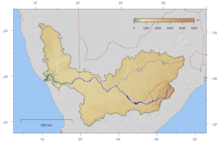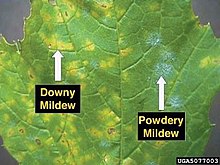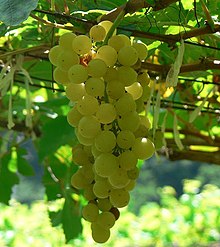South African wine

South African wine has a history dating back to 1659 with the first bottle being produced in
There are about 60
History
The roots of the South African wine industry can be traced to the explorations of the
Many growers gave up on winemaking, and instead chose to plant orchards and
For much of the 20th century, the South African wine industry received minimal international attention. Its isolation was exacerbated by the
In the 21st century, there has been a focus on the growing collective of black winemakers in South Africa.[5][6] Several black entrepreneurs whose ancestry faced the system of Apartheid rose into winemaking prominence, such as Ntsiki Biyela and Paul Siguqa.
Climate and geography

South Africa is located at the tip of the African continent with most wine regions located near the coastal influences of the Atlantic and Indian Oceans. These regions have a mostly
During the harvest months of February and March, the average daily temperatures in many South African wine regions is 23 °C (73 °F) with spikes up to 40 °C (104 °F) not uncommon in the warm inland river valleys around the
The wine regions of South Africa are spread out over the
Statistics
South Africa is the eighth largest wine producer in the world and the world's sixth largest exporter of wine. South Africa exports R10.3 billion (roughly US$600 million) worth of wine annually. In 2022 a total of 90,512 hectares of land used for wine grape cultivation by 2,613 wine grape producers for 536 cellars, the industry employed 269,096 people. The country produces 1.13 billion liters of wine annually with 81% being consumed domestically. In 2019 the wine industry's contribution to the national economy was R55 billion.[9]
Wine of Origin

Drafted in 1973, the "Wine of Origin" (WO) programme legislates how wine regions of South Africa are defined and can appear on
Wine regions

As of 2003, South Africa was 17th in terms of area planted with vines, with the country owning 1.5% of the world's grape vineyards with 110,000 hectares (270,000 acres). Yearly production among South Africa's wine regions is usually around 10 million hL (264 million US gallons) which regularly puts the country among the top ten
Below are some notable Wine of Origins districts.[4]
Constantia

The Constantia Valley is located south of Cape Town on the Cape Peninsula that juts out into the Atlantic Ocean. Because of its location, the region receives oceanic influences on each side that create a cooling effect contributing to a long, slow
Stellenbosch

The Stellenbosch district is the second oldest wine region in South Africa, after Constantia, and is responsible for around 14% of the country's annual wine production. First planted in 1679, Stellenbosch is located 45 kilometres (28 mi) east of Cape Town. The region is surrounded by the
The seven wards of Stellenbosch-Banghoek, Bottelary, Devon Valley, Jonkershoek Valley, Papegaaiberg, Polkadraai Hills and Simonsberg-Stellenbosch – are well known for their red wine production that demonstrate terroir distinction – particularly Cabernet Sauvignon, Merlot, Pinotage and Shiraz.[4] Simonsberg was the first wine ward to gain individual distinction. White wine production centres on Chardonnay and Sauvignon blanc which are often blended together. The western reaches of Stellenbosch, such as Bottelary and near Elsenburg also include a sizeable portion of Chenin blanc plantings in areas rich in light, sandy soils.[7]
Paarl

For most of the 20th century, Paarl was for all practical purposes the heart of the South African wine industry. It was the home of the KWV as well as the annual
The fortified wine produced in Paarl and nearby Tulbagh can be designated with the unique WO of Boberg relating to its proximity to the Berg River.[8] This was repealed in 2019 and is no longer an approved label designation.[11]
Franschhoek Valley
The Franschhoek Valley was founded by
Franschhoek will soon be South Africa's first wine region to form a classification system (Appellation Grand Prestige) for its wines, with
Breede River Valley

The Breede River Valley, located east of the Drakenstein Mountains, is a warm climate region that can be very dry and arid in some places.
The
Overberg
The cool climate Overberg region has been the site of the most recent interest and development in the South African wine industry, particularly with increased plantings of Chardonnay and
Other notable regions

The Klein Karoo region (meaning
The Atlantic influenced West Coast region includes the wine making areas of
The
KwaZulu-Natal was designated as a Geographical Unit in 2005 and is one of South Africa's most recent wine regions. The first wine estate in this region was The Stables Wine Estate, and the region's first Wine of Origin wine was released by Tiny and Judy van Niekerk in July 2006. The Stables Wine Estate went bankrupt in 2012.[12] Current cultivars doing well in the growing wine region of KwaZulu-Natal are: Sauvignon Blanc, Pinotage, Pinot Noir and Chardonnay. With mild summer temperatures, the region boasts South Africa's coolest vineyards.
The Eastern Cape followed soon after through the pioneering efforts of Ronnie and Janet Vehorn. In 2009, Harrison Hope Wine Estate was registered as the first wine estate in the Eastern Cape province of South Africa. The estate made history again with its 2009 Merlot becoming the first certified estate wine ever produced in the Eastern Cape region.[
Other notable wards
The Ruiterbosch ward, located southwest of the Klein Karoo around Mossel Bay, has a generally cool climate influenced primarily by the Indian Ocean. The area is planted largely with Riesling, Sauvignon blanc and Pinot noir.[4] The Cederberg located east of the southern reaches of the Olifants rivers includes some of the highest elevated vineyards in South Africa, planted at altitudes more than 1,000 metres (3,300 ft).[8]
Viticulture
Historically vineyards in South Africa were planted with

The lack of precipitation in many wine regions make irrigation a necessity. Sprinkler and
While ocean winds keep some fungus and mildew threats at bay,
Vine Improvement Programme
Following the end of Apartheid and the opening of export markets, the South African wine industry had a substantial learning curve to overcome in order to be competitive on the world's wine market. The Vine Improvement Programme (VIP) was established to bring modern viticultural understanding to the industry. The first phase launched in the late 20th century focused on virus-free and yield controlling rootstock as well as clonal research. The second phase, which is ongoing, focuses on matching up various combinations of grape varieties, clones and rootstock to specific terroir that can produce quality wine. Over the last 20+ years, the work of the VIP has brought the South African wine industry to the forefront of viticultural advances.[8]
Winemaking and wines


The winemaking traditions of South Africa often represent a hybridisation of
Today the focus of the South African wine industry is on increasing the quality of wine production – particularly with the more exportable and fashionable red grape varieties. Traditionally, South African red wines had a reputation for being coarse in texture with rustic flavours. The
Cape port-style wine
The South African wine industry has a long history of fortified wine production producing wines known colloquially as "Cape port" (though the term "
- Cape White port – Can be made from any white grape varieties (such as Chenin blanc, Colombard or Fernão Pires) except for Muscats. Required to be aged in wood barrels for at least six months.
- Cape Ruby port – Usually a blend of several fruity, full bodied wines that have been aged for at least six months in wood for each wine and at least a year total for the entire blend.
- Cape Tawny port – A blend that has been aged in wood long enough to acquire a tawny colour with a smooth, slightly nutty flavour. Blending Ruby and White ports to create Tawny port is prohibited.
- Cape Late Bottled Vintage (LBV) port – A wine composed of grapes harvested in a single vintage that is aged at least two years in oak and three to six years total before being bottled. South Africa wine laws require that the term "Late Bottled Vintage" or "LBV" appear on the wine label along with the vintage and bottling year.
- Cape Vintage port – A wine composed of grapes harvested in a single vintage, aged in wood and released with the words "Vintage Port" and the vintage year on the label.
- Cape Vintage Reserve port – A wine produced in a vintage year recognised by the South African wine industry or trade publications as being of exceptional quality. The wine must be aged for at least one year in oak and sold exclusively in glass wine bottles. The words "Vintage Reserve Port" and vintage date must appear on the wine label.
Other fortified and dessert wines
In addition to port-style wine, South African wine makers also produce "
Sparkling wines

Labelling laws
South African labelling law focuses largely on geographical origins, falling under the purview of the Wine of Origin legislation.
Grape varieties
| Grape | Vineyards[14] | |
|---|---|---|
| Chenin Blanc |
| |
| Cabernet Sauvignon |
| |
| Colombard |
| |
| Shiraz |
| |
| Sauvignon Blanc |
| |
| Chardonnay |
| |
| Pinotage |
| |
| Merlot |
|
Grape varieties in South Africa are known as
From the 1990s, plantings of red grape varieties rose steadily. In the late 1990s, less than 18% of all the grapes grown in South Africa were red. By 2009 that number had risen to 44%. For most of the 20th century, the high yielding Cinsaut was the most widely planted red grape variety, but the shift in focus to quality wine production has seen plantings of the grape steadily decline to where it represented just 2% of all South Africa vineyards in 2009.
There is a wide range of lesser known groups that are used to feed the country's still robust distilled spirits and fortified wine industry. These grapes usually produce bland, neutral wine that lends itself well to blending and distillation but is rarely seen as varietal bottlings. These include: Belies, False Pedro, Kanaän, Raisin blanc, Sultana and Servan.[4]
Pinotage
Pinotage, a crossing of
Important organisations
The South African wine industry has been led by many powerful organisations in both the private sector and through governmental agencies. Unlike other New World wine regions, the South African wine industry is largely influenced by several large co-operatives.
The Wine & Spirits board also operates the South African Wine Industry Trust (SAWIT) and provides funding for the marketing and development of SAWIT. Established in 1999 by a joint agreement between the South African government and the KWV, which put forth 369 million rand ($46 million US$), SAWIS works to promote the export market for South African wines abroad, and the development of new technologies and education. Additionally, SAWIS works with the Black Economic Empowerment (BEE) programme to promote the black community's involvement in the South African wine industry – including ownership opportunities for vineyards and wineries.[4]
South African wine competitions
Wine competitions are held to assess whether a wine is of good quality and whether it is true to its character. The most prominent South African wine competitions include:[19]
- ABSA Top 10 Pinotage
- Amorim Cap Classique Challenge
- Diners Club Winemaker of the Year
- FNB Sauvignon Blanc Top 10
- Michelangelo International Wine & Spirits Awards
- Old Mutual Trophy Wine Show
- Shiraz SA Challenge
- Standard Bank Chenin Blanc Top 10 Challenge
- Veritas Awards
See also
Further reading
- Nugent, Paul (2024). Race, Taste and the Grape: South African Wine from a Global Perspective. Cambridge University Press.
References
- ^ "Wine of Origin booklet" (PDF). SAWIS. 2016. Retrieved 20 June 2007.
- JSTOR 10.1525/j.ctt7zw0st.
The origins of winegrowing in South Africa can be fixed with unusual accuracy. A crucial moment was recorded on 2 February 1659 in the logbook of Jan van Riebeeck, commander of the tiny settlement at the foot of Africa.
- ^ "The first wine is pressed at the Cape". South African History Online. Retrieved 1 February 2018.
Jan van Riebeeck writes in his journal that the harvest amounted to twelve "mengelen" (about fourteen litres) of must.
- ^ ISBN 0-19-860990-6.
- ^ Eligon, John (15 February 2023). "Exploring South Africa's Black Wine Scene". The New York Times. Retrieved 16 February 2024.
- ^ MW, Tim Atkin (11 November 2022). "South Africa's black winemakers; building a future". Decanter. Retrieved 16 February 2024.
- ^ ISBN 1-84000-332-4.
- ^ ISBN 0-7566-1324-8.
- ^ "Statistics of Wine Grape Vines | SAWIS". www.sawis.co.za. Retrieved 14 February 2023.
- ^ Fairbridge, Dorothea (1922). Historic houses of South Africa. London: H. Milford, Oxford University Press.
- ^ https://www.wosa.co.za/wosadocs/52020/Production_areas_-_May2020.pdf [bare URL PDF]
- ^ HighBeam
- ^ M. Mazur "THE CAPE CRUSADERS Archived 29 October 2013 at the Wayback Machine" Wine Enthusiast Magazine, 1 October 2002
- ^ a b "Statistics of Wine-Grape Vines". sawis.co.za. SAWIS. Retrieved 1 March 2017.
- ^ a b c Platter's South African Wines 2011 Andrew McDowall 2010, pp. 47–48
- ^ Stuart Walton, Understanding, Choosing and Enjoying Wine Hermes House 2006, p. 226
- ISBN 0-19-860990-6.
- ^ John Platter South African Wines 2007 Andrew McDowall 2010, p. 59
- ^ WOSA - Wine Competitions
External links
- WO booklet from SAWIS, gives history and has maps of the appellations
- Wines of South Africa (WOSA) Industry body
- ABSA Top 10 Pinotage South African Pinotage Wine Competition
- Mosaic Top 5 Pinot Noir Wine Awards South African Pinot Noir Wine Competition
- Veritas Awards General South African Wine Competition
